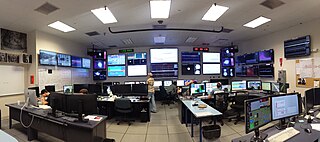
The Laser Interferometer Gravitational-Wave Observatory (LIGO) is a large-scale physics experiment and observatory designed to detect cosmic gravitational waves and to develop gravitational-wave observations as an astronomical tool. Two large observatories were built in the United States with the aim of detecting gravitational waves by laser interferometry. These observatories use mirrors spaced four kilometers apart which are capable of detecting a change of less than one ten-thousandth the charge diameter of a proton.
Livingston is the parish seat of Livingston Parish, Louisiana, United States. The population was 1,769 at the 2010 census.

Rainer "Rai" Weiss is a German-born American physicist, known for his contributions in gravitational physics and astrophysics. He is a professor of physics emeritus at MIT and an adjunct professor at LSU. He is best known for inventing the laser interferometric technique which is the basic operation of LIGO. He was Chair of the COBE Science Working Group.

GEO600 is a gravitational wave detector located near Sarstedt, a town 20 km to the south of Hanover, Germany. It is designed and operated by scientists from the Max Planck Institute for Gravitational Physics, Max Planck Institute of Quantum Optics and the Leibniz Universität Hannover, along with University of Glasgow, University of Birmingham and Cardiff University in the United Kingdom, and is funded by the Max Planck Society and the Science and Technology Facilities Council (STFC). GEO600 is capable of detecting gravitational waves in the frequency range 50 Hz to 1.5 kHz, and is part of a worldwide network of gravitational wave detectors. This instrument, and its sister interferometric detectors, when operational, are some of the most sensitive gravitational wave detectors ever designed. They are designed to detect relative changes in distance of the order of 10−21, about the size of a single atom compared to the distance from the Sun to the Earth. Construction on the project began in 1995.

Ronald William Prest Drever was a Scottish experimental physicist. He was a professor emeritus at the California Institute of Technology, co-founded the LIGO project, and was a co-inventor of the Pound–Drever–Hall technique for laser stabilisation, as well as the Hughes–Drever experiment. This work was instrumental in the first detection of gravitational waves in September 2015.

The Kamioka Gravitational Wave Detector (KAGRA), is a large interferometer designed to detect gravitational waves predicted by the general theory of relativity. KAGRA is a Michelson interferometer that is isolated from external disturbances: its mirrors and instrumentation are suspended and its laser beam operates in a vacuum. The instrument's two arms are three kilometres long and located underground at the Kamioka Observatory which is near the Kamioka section of the city of Hida in Gifu Prefecture, Japan.

The Virgo interferometer is a large Michelson interferometer designed to detect gravitational waves predicted by the general theory of relativity. It is located in Santo Stefano a Macerata, near the city of Pisa, Italy. The instrument's two arms are three kilometres long, housing its mirrors and instrumentation inside an ultra-high vacuum.
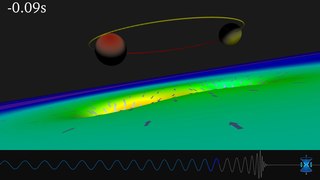
Gravitational waves are waves of the intensity of gravity that are generated by the accelerated masses of an orbital binary system, and propagate as waves outward from their source at the speed of light. They were first proposed by Oliver Heaviside in 1893 and then later by Henri Poincaré in 1905 as waves similar to electromagnetic waves but the gravitational equivalent.

A gravitational-wave detector is any device designed to measure tiny distortions of spacetime called gravitational waves. Since the 1960s, various kinds of gravitational-wave detectors have been built and constantly improved. The present-day generation of laser interferometers has reached the necessary sensitivity to detect gravitational waves from astronomical sources, thus forming the primary tool of gravitational-wave astronomy.
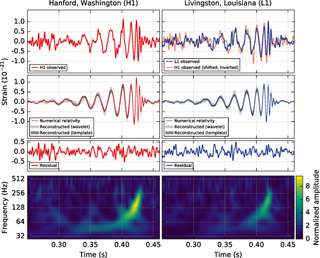
Gravitational-wave astronomy is an emerging field of science, concerning the observations of gravitational waves to collect relatively unique data and make inferences about objects such as neutron stars and black holes, events such as supernovae, and processes including those of the early universe shortly after the Big Bang.

Alessandra Buonanno is an Italian naturalized-American theoretical physicist and director at the Max Planck Institute for Gravitational Physics in Potsdam. She is the head of the "Astrophysical and Cosmological Relativity" department. She holds a research professorship at the University of Maryland, College Park, and honorary professorships at the Humboldt University in Berlin, and the University of Potsdam. She is a leading member of the LIGO Scientific Collaboration, which observed gravitational waves from a binary black-hole merger in 2015.
David Howard Reitze is an American laser physicist who is professor of physics at the University of Florida and served as the scientific spokesman of the Laser Interferometer Gravitational-Wave Observatory (LIGO) experiment in 2007-2011. In August 2011, he took a leave of absence from the University of Florida to be the Executive Director of LIGO, stationed at the California Institute of Technology, Pasadena, California. He obtained his BA in 1983 from Northwestern University, his PhD in physics from the University of Texas at Austin in 1990, and had positions at Bell Communications Research and Lawrence Livermore National Laboratory, before taking his faculty position at the University of Florida. He is a Fellow of the American Physical Society, the Optical Society, and the American Association for the Advancement of Science.
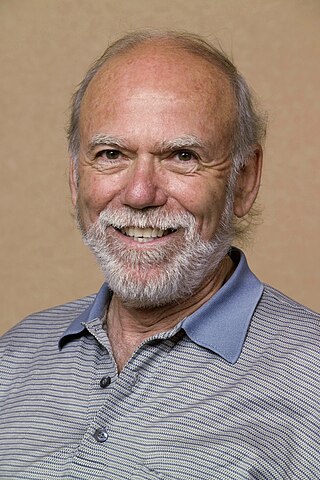
Barry Clark Barish is an American experimental physicist and Nobel Laureate. He is a Linde Professor of Physics, emeritus at California Institute of Technology and a leading expert on gravitational waves.

Gabriela Ines González, is a professor of physics and astronomy at the Louisiana State University and was the spokesperson for the LIGO Scientific Collaboration from March 2011 until March 2017.

The first direct observation of gravitational waves was made on 14 September 2015 and was announced by the LIGO and Virgo collaborations on 11 February 2016. Previously, gravitational waves had been inferred only indirectly, via their effect on the timing of pulsars in binary star systems. The waveform, detected by both LIGO observatories, matched the predictions of general relativity for a gravitational wave emanating from the inward spiral and merger of a pair of black holes of around 36 and 29 solar masses and the subsequent "ringdown" of the single resulting black hole. The signal was named GW150914. It was also the first observation of a binary black hole merger, demonstrating both the existence of binary stellar-mass black hole systems and the fact that such mergers could occur within the current age of the universe.
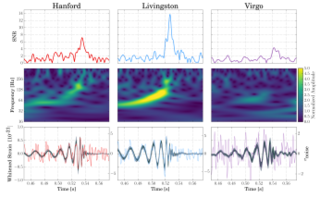
GW170814 was a gravitational wave signal from two merging black holes, detected by the LIGO and Virgo observatories on 14 August 2017. On 27 September 2017, the LIGO and Virgo collaborations announced the observation of the signal, the fourth confirmed event after GW150914, GW151226 and GW170104. It was the first binary black hole merger detected by LIGO and Virgo together.
PyCBC is an open source software package primarily written in the Python programming language which is designed for use in gravitational-wave astronomy and gravitational-wave data analysis. PyCBC contains modules for signal processing, FFT, matched filtering, gravitational waveform generation, among other tasks common in gravitational-wave data analysis.
Peter Reed Saulson is an American physicist and professor at Syracuse University. He is best known as a former spokesperson for the LIGO collaboration serving from 2003 to 2007 and research on gravitational wave detectors.
Lisa Barsotti is a research scientist at the Massachusetts Institute of Technology Kavli Institute.













